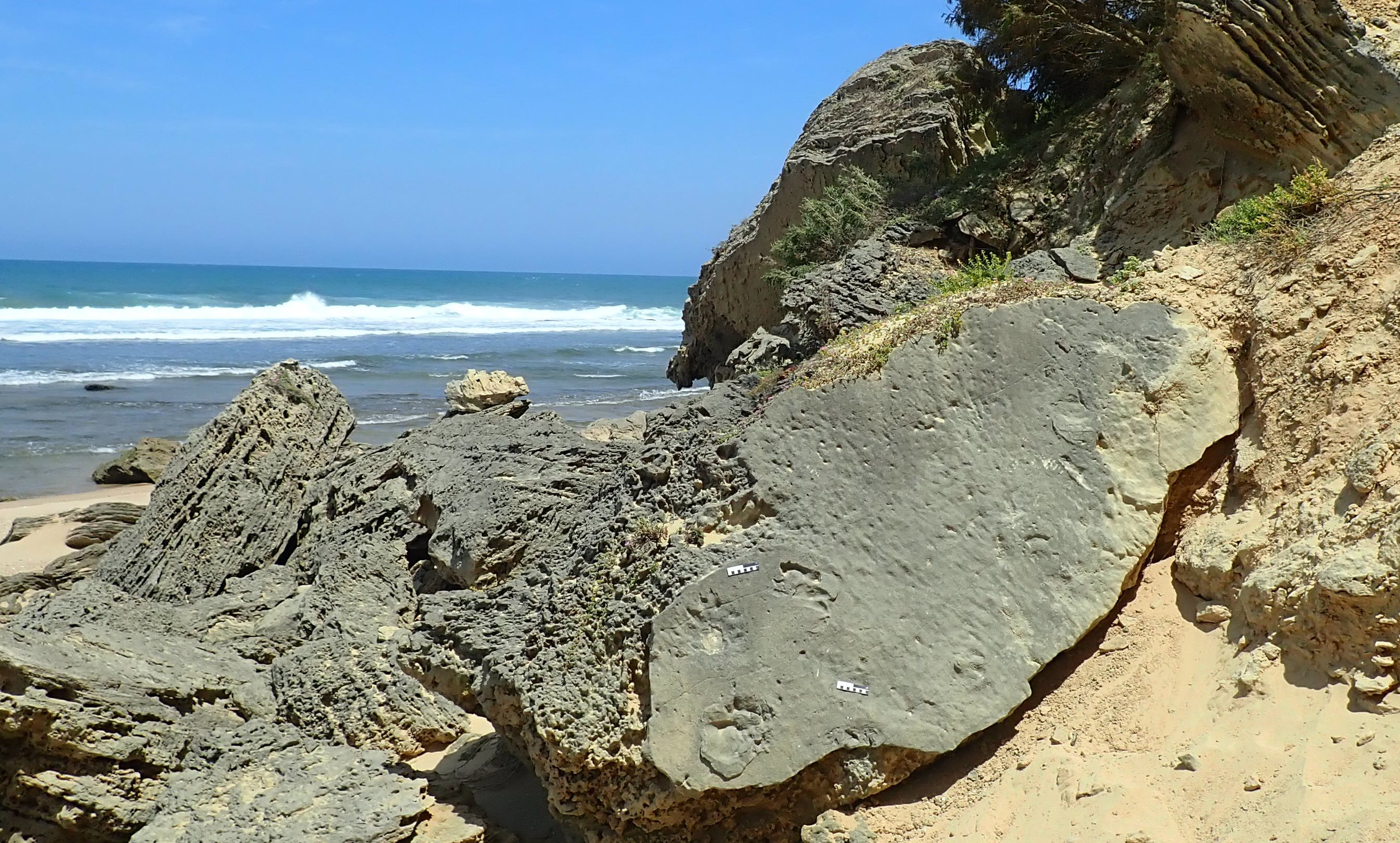Across a boulder, overlooking the sea, a set of animal tracks were testing Alex van den Heever’s tracking skills.
Van den Heever has an impressive resumé when it comes to tracking. He has tracked grizzly bears in Canada, followed spoor left by lions in South Africa and successfully stalked a puma in Patagonia.
 Dr Charles Helm demonstrates how he believes a circle was drawn in the sand, thousands of years ago. He had discovered the remains of what he and his team interpreted as a circle that was drawn by human hunter-gatherers. (Photo: Dr Charles Helm)
Dr Charles Helm demonstrates how he believes a circle was drawn in the sand, thousands of years ago. He had discovered the remains of what he and his team interpreted as a circle that was drawn by human hunter-gatherers. (Photo: Dr Charles Helm)
But the footprints on that boulder were unlike anything he had tracked before. For one thing, the spoor was old, so old that when the animal left its mark mammoths still roamed the northern hemisphere and humans had yet to give up their wandering ways and settle down.
Van den Heever took his time and, eventually, after consulting other top trackers, fingered the animal he believed to be responsible for the tracks. He said it was a crocodile.
“I went to the site and I identified the tracks cold, without any assistance,” says Van den Heever. “I then photographed them and sent them out on a sort of peer review system – to a community of trackers, of which 80% came back with the same answer.”
Another contender was a large water monitor or leguaan.
The discovery that crocodiles once roamed this corner of what is now Southern Cape about 120,000 years ago provides an important clue about what climate conditions were like back then. Today crocodiles aren’t found in this area, which forms part of the Garden Route National Park. The limiting factor for the crocodile — and the water monitor — is temperature.
 An ancient preserved human footprint. (Photo: Dr Charles Helm)
An ancient preserved human footprint. (Photo: Dr Charles Helm)
“As you go further south, the temperatures get cooler and they don’t survive in those cooler temperatures,” explains Dr Charles Helm of the African Centre for Coastal Palaeoscience at Nelson Mandela University.
“Now everyone thinks of the Pleistocene as the period of ice ages. But there were reasonably short periods of warm temperatures which sort of came between the true cold ice ages.”
Helm is the lead author of a recent academic paper that describes the crocodile prints. Crocodiles, the paper highlights, are limited to tropical and subtropical areas that have a temperature range of between 25 and 35 degrees Celsius.
 The markings on these rocks are believed to have been left by a large reptile. (Photo: Dr Charles Helm)
The markings on these rocks are believed to have been left by a large reptile. (Photo: Dr Charles Helm)
Sharing this landscape were early humans and, they too, left their tracks on this 350-kilometre bit of coastline that stretches from Arniston in the west to Robberg in the east.
Besides footprints, Helm and his team have found drawings they believe are tens of thousands of years old and that were left in the sand. One drawing is of a circle and Helm believes it was made with a stick.
How these footprints and drawings weren’t blown away in the wind, all those eons ago, had to do with a mix of conditions that allowed for rapid preservation.
 The markings on these rocks are believed to have been left by a large reptile. (Photo: Dr Charles Helm)
The markings on these rocks are believed to have been left by a large reptile. (Photo: Dr Charles Helm)
Helm explains the process: “So you’ve got a dune surface or a beach surface, where the tracks are. A light drizzle or mist moistens the tracks and then you get a wind that comes in and blows another layer on top of it. And so now you’ve covered it and now it gets buried for a hundred thousand years, it gets compacted and the chemical processes make it harden.”
The quality of the tracks vary and because of this experienced trackers like Van den Heever are needed to interpret the spoor. In fact, interpreting these ancient tracks is becoming a growing industry worldwide.
In France, scientists have been using the skills of three Bushmen/San trackers from Namibia to help examine footprints left by early humans who ventured deep into caves tens of thousands of years ago. These Namibian trackers are so good they have provided the scientists with not only an interpretation of what the humans were doing in the caves but also their ages and sexes.
Along the Southern Cape coastline, more tracks are to be found. To help locate them, the plan is to employ full-time trackers.
At the Tracker Academy in Graaff-Reinet, a young man has recently begun tracker training.
“We have an agreement with Cape nature conservation. They identify people who have grown up in these coastal regions and show an aptitude for tracking. They then send them to our academy, where we train them. Once they graduate, they go back to Cape Nature, where they'll be employed to specifically go and find and interpret fossil tracks,” says Van den Heever, a founder of the Tracker Academy.
A new breed of trackers is out there tracking down prehistoric game; but what do you call them?
“I don’t know, maybe fossil trackers. But that is not quite right as we are not tracking fossils, we are looking for fossil tracks. I just don’t know,” laughs Van den Heever. DM




 The markings on these rocks are believed to have been left by a large reptile. (Photo: Dr Charles Helm)
The markings on these rocks are believed to have been left by a large reptile. (Photo: Dr Charles Helm)